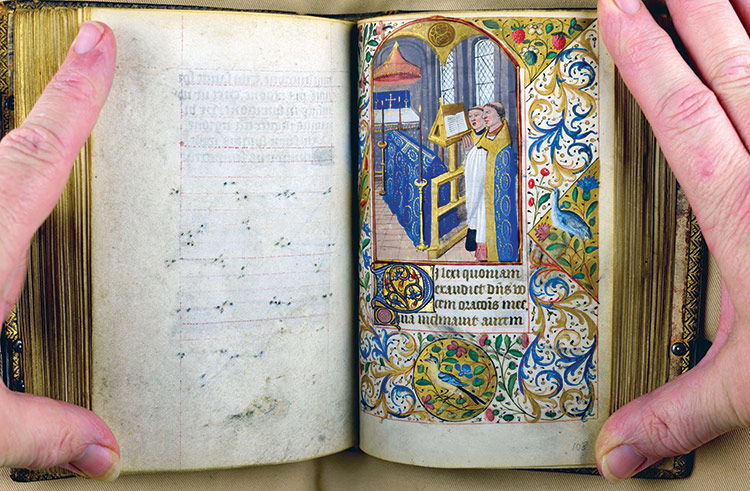Tokens of Affection
What do pilgrim badges tell us about emotion in the Middle Ages?
 How can dirty marks in an old book help us access a medieval reader’s emotions? Why is it important that we try to establish such connections? The history of emotions is a new field but one that encourages a wider public engagement with history. Emotions are accessible: we all understand and experience anger, pity, love and hate. These feelings help us make links to those who previously expressed them and open up new pathways to understand how people in the past felt about their world. Historians search literary and documentary evidence for publicly expressed emotions, if not interior feelings. Public emotions are revealed in the rhetoric of medieval writers, who were trained to express pathos to their readership and so inspire emotional responses by making clear their own feelings, which were considered just as important as putting forward rational arguments. Yet what about those non-literate people who were barely or never recorded? How might we learn about their feelings?
How can dirty marks in an old book help us access a medieval reader’s emotions? Why is it important that we try to establish such connections? The history of emotions is a new field but one that encourages a wider public engagement with history. Emotions are accessible: we all understand and experience anger, pity, love and hate. These feelings help us make links to those who previously expressed them and open up new pathways to understand how people in the past felt about their world. Historians search literary and documentary evidence for publicly expressed emotions, if not interior feelings. Public emotions are revealed in the rhetoric of medieval writers, who were trained to express pathos to their readership and so inspire emotional responses by making clear their own feelings, which were considered just as important as putting forward rational arguments. Yet what about those non-literate people who were barely or never recorded? How might we learn about their feelings?
Medieval pilgrimage was a significant source of material objects that address emotion. The historian Brian Spencer was the first to point out the importance of pilgrim badges or tokens as a means to explore medieval ritual, practice and belief. Inexpensive metal badges (sometimes gold ones, too) were bought as souvenirs by pilgrims who venerated saints’ relics at popular shrines. Badges were made in their thousands in Britain and on the Continent, to be sewn or pinned to the clothing of those making a return journey as an important part of the pilgrimage ritual. Pilgrim badges might be given to others too sick to travel, or hung in the local parish church as evidence of a completed pilgrimage. They were usually bought just outside the shrine and, once inside, pilgrims might hold their tokens against the reliquary or tomb of the saint. This was a way to bring home to others some of the holiness invested in the relics. Ampullae (little lead vessels) were filled with holy water from the site. Those from Canterbury Cathedral allegedly contained infinitesimal specks of Thomas Becket’s blood and were considered medicinal; a Museum of London exhibit announces in Latin ‘Thomas is the best doctor of the worthy sick’. Such tokens might be used as a defence against evil or bad luck. Other pilgrim badges point to political contexts, such as those for Thomas of Lancaster, executed for his revolt against Edward II in 1322. One little-discussed aspect marks them not as carriers of belief, or healing, or political statements, but as bearers of emotional meaning.
This is where the ‘dirty marks’ come in. Inside a mid-15th-century French Book of Hours at Canterbury Cathedral Archives and Library, there are some marks and holes on a blank folio. Closer investigation reveals these marks to be the impressions made by 12 pilgrim tokens once stitched onto the parchment. On the next right-hand folio there is a half-page miniature depicting a funeral to illustrate the Office of the Dead. The tokens were placed so that the stitching would not damage the image. These mementoes were stitched into a book used for daily prayers, as close as possible to the litany for the remembrance of the dead. This means the tokens might represent shared pilgrimages with someone no longer alive. Or the pilgrimages may have been undertaken for the good of the soul of someone close to the book’s owner, as souls remembered in prayers secured an earlier release from the pains of purgatory. These tokens embody the prayers of someone bereft; they are material witnesses to the act of grieving and a method of remembrance and commemoration. No writing was required; no names or marginalia adorn this book. Yet these tokens represent an absent presence, just as they did to the person who once stitched them into place. They signify grief, hope and devotion: human emotions remembered in repeated private prayers.
These sewn-in tokens are not unique. Christopher de Hamel, head of the Parker Library at Corpus Christi, Cambridge, thinks that as many as 20 per cent of extant Books of Hours bear evidence of pilgrim tokens. Even though few tokens themselves survive in situ, they leave behind evidence of being affixed to Books of Hours that survive in such quantities they are (almost) affordable. Many digitised examples are now online, including ones with pilgrim badge marks, which reveal something of the emotions of their previous early owners, who were frequently women. This stitching of pilgrim tokens is as much a marking of the Hours as the marginalia the historian Eamon Duffy has noted and allows us some access to the feelings of those who could not write but sought nevertheless to attest their remembrance and love.
Diane Heath is an assistant lecturer at Canterbury Christ Church University. The Medieval Canterbury Weekend runs from April 1st to 3rd, 2016.




